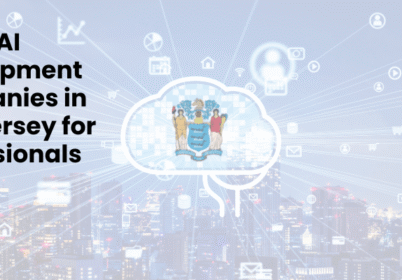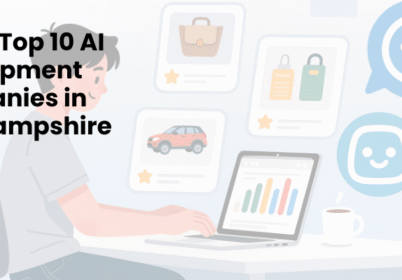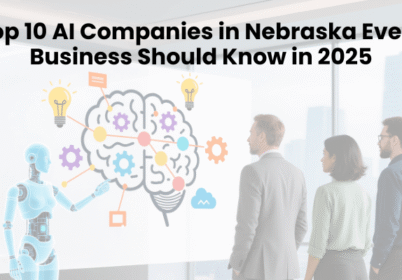How to Use Napkin AI: A Step-by-Step Guide to Transforming Text into Visuals
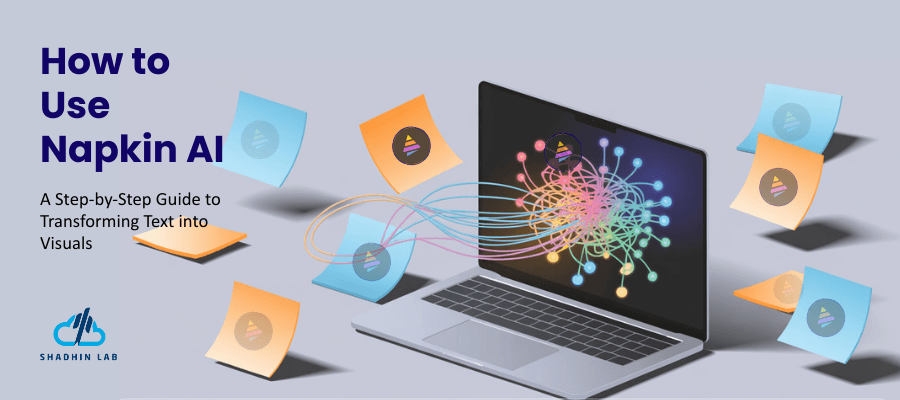
Table of Contents
Do you often find yourself full of ideas but struggling to organize or connect them in a meaningful way? You are in the right place because Napkin AI is designed to turn scattered notes into structured knowledge that works for you. This innovative platform represents a significant advancement in AI-powered thinking tools and knowledge management systems. Imagine having a digital companion that not only stores your ideas but also shows you how they connect in ways you may have never considered. It gives you the power to build living networks of ideas without requiring a steep learning curve, making the process feel natural and intuitive.
Artificial intelligence has revolutionized the landscape of digital note-taking and idea management in recent years. Imagine moving beyond static notebooks into a tool that thinks alongside you and grows with every idea you add. Learning how to use Napkin AI effectively can transform your creative thinking and productivity workflow. By the end of this guide, you will know exactly how to capture, organize, and connect your thoughts with clarity.
主要ポイント
- Readers will understand what Napkin AI is and how it differs from traditional note-taking tools.
- They will learn step-by-step how to use Napkin AI, from setup to capturing and organizing ideas.
- They will discover advanced ways to leverage Napkin AI for brainstorming, research, and project planning.
- They will gain clarity on Napkin AI’s pricing, limitations, and best practices for maximum productivity.
- They will leave with actionable knowledge to integrate Napkin AI into their personal or professional workflow.
Table of Contents
What is Napkin AI?
Napkin AI functions as an intelligent creative assistant designed to enhance your thinking and note-taking processes. The platform expertly captures fragmented thoughts and transforms them into connected knowledge networks through sophisticated artificial intelligence. Unlike traditional note-taking applications, Napkin AI actively generates connections between ideas that might otherwise remain isolated in your workflow.
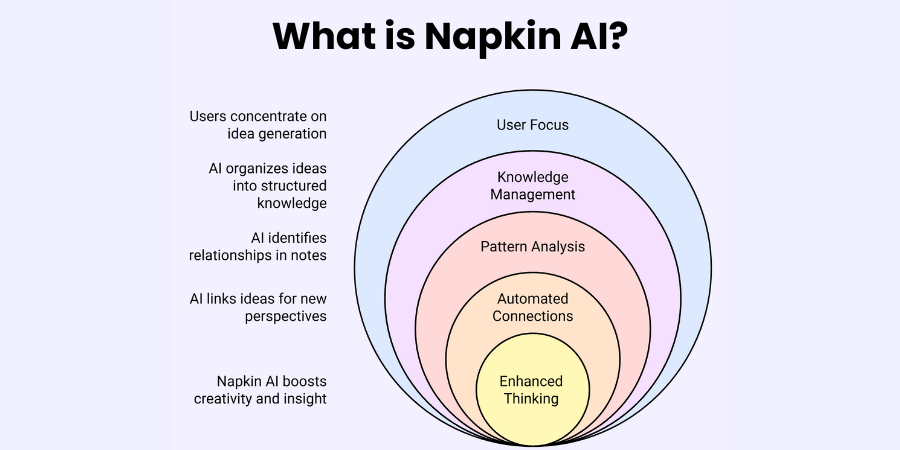
The system carefully analyzes content patterns across your notes to suggest relevant relationships and potential new directions for exploration. This approach differs fundamentally from conventional tools that require manual organization and deliberate connection-building between related concepts. Napkin AI serves simultaneously as both repository and thinking partner, helping users discover insights they might have otherwise missed. The platform’s name cleverly evokes the spontaneous nature of jotting ideas on napkins during moments of unexpected inspiration.
Napkin AI preserves this natural spontaneity while adding powerful organizational capabilities through advanced machine learning algorithms. The tool effectively bridges the gap between unstructured brainstorming sessions and structured knowledge management with minimal user effort. Users can focus entirely on generating valuable ideas while the system handles the complex work of categorization and connection.
Key Features of Napkin AI
Napkin AI offers several distinctive capabilities that set it apart from conventional note-taking and idea management tools:
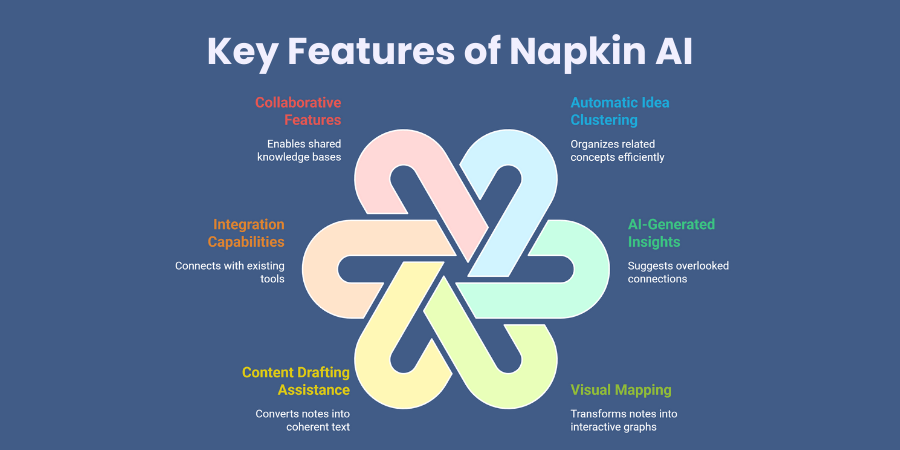
- Automatic idea clustering stands as one of its most powerful features for organizing related concepts
- AI-generated insights that suggest connections you might have overlooked between seemingly unrelated ideas
- Visual mapping that transforms your notes into interactive knowledge graphs for intuitive navigation
- Content drafting assistance to transform rough notes into coherent paragraphs or outlines
- Integration capabilities allowing Napkin AI to connect with existing workflows and tools
- Collaborative features enabling teams to build shared knowledge bases with AI-enhanced connections
The system identifies patterns across your notes and groups similar thoughts without requiring manual categorization. These insights often reveal relationships between seemingly unrelated ideas, sparking new creative directions for your projects. Users can explore their ideas spatially, revealing relationships that might remain hidden in traditional linear formats.
The system can expand simple bullet points into well-structured paragraphs or suggest organizational structures for your content. The platform works alongside research databases, writing applications, and project management systems for maximum productivity. Multiple team members can contribute ideas while the system helps identify overlaps and opportunities for collaboration.
Napkin AI Dashboard & Interface Walkthrough
The Napkin AI dashboard presents a clean, intuitive interface designed for both visual thinkers and text-oriented users. Upon logging in, users encounter the central workspace displaying recent notes and AI-generated connection maps. The left sidebar contains navigation options including Home, Collections, Tags, and Settings for quick access. The top navigation bar features search functionality, notification alerts, and user profile access for account management.
The central workspace adapts based on your current activity, showing either individual notes or relationship maps. Notes appear as cards containing text, images, or links that can be expanded for detailed viewing. The visual mapping area displays interconnected nodes representing ideas with lines showing relationships between concepts. Color coding helps distinguish between different categories, projects, or importance levels within your knowledge network. The AI insights panel appears on the right side, showing suggested connections and potential new directions.
This panel can be collapsed when focusing on content creation or expanded when seeking inspiration. The tagging system allows for manual categorization alongside the automatic clustering performed by the AI. Custom tags help organize content according to your personal organizational system while maintaining AI connections.
How to Use Napkin AI: Step-by-Step Guide
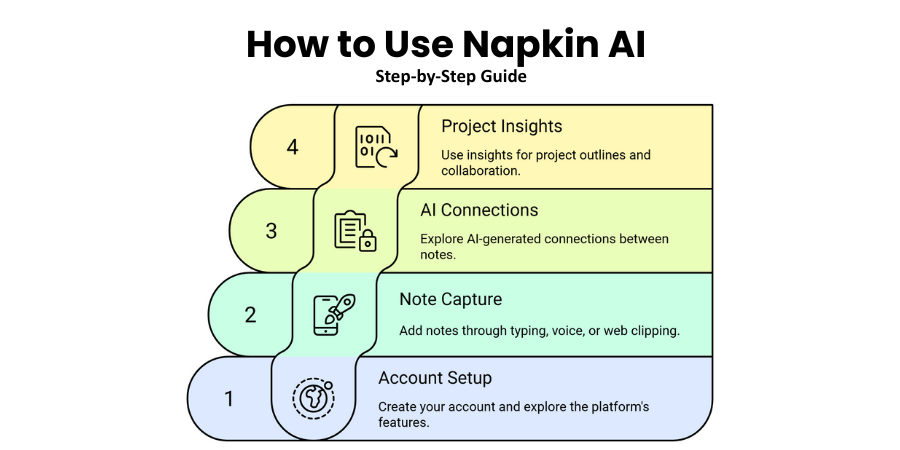
Getting Started with Napkin AI
Creating your Napkin AI account requires visiting the official website and selecting a subscription plan. The registration process asks for basic information including email address, password, and optional professional details. After account creation, Napkin AI offers a guided tour highlighting key features and basic functionality. The onboarding process includes sample notes and connections demonstrating the platform’s capabilities in practical scenarios.
New users should begin by exploring these examples to understand the system’s approach to knowledge management. Installing the browser extension enhances functionality by enabling direct capture from web pages and articles. The mobile application allows for on-the-go idea capture and seamless synchronization across all your devices.
Capturing and Organizing Notes
Adding your first notes to Napkin AI can happen through direct typing, voice recording, or web clipping. The quick capture feature allows for rapid idea entry without disrupting your creative flow or research process. Each note can contain text, images, links, or combinations of different content types for truly comprehensive capture. Tagging notes helps establish initial categories while the AI begins identifying patterns across your content.
The system recognizes important concepts automatically, but manual tagging improves early organization and retrieval. Organizing notes into collections creates higher-level groupings for projects, research areas, or knowledge domains. Collections function as containers while still allowing cross-collection connections when the AI identifies meaningful relationships.
Exploring AI-Generated Connections
The connection map visualizes relationships between your notes based on content similarity and conceptual links. Clicking any node in this map reveals related ideas and potential new directions for exploration. The AI continuously refines these connections as you add more content to your knowledge base. Connection strength indicators show how closely related different ideas are within your knowledge network.
Users can manually strengthen or weaken connections based on their understanding of conceptual relationships. The discovery panel suggests entirely new connections that might not be immediately obvious from the content. These suggestions often reveal unexpected patterns or opportunities for innovation within your existing knowledge.
Using Insights for Projects
Exporting insights from Napkin AI supports various output formats including text, images, and structured data. The platform can generate outlines based on connected ideas for writing projects or presentations. Content drafting features help transform clusters of related notes into coherent paragraphs or sections. Project templates provide starting structures for common outputs like articles, research papers, or business plans.
The collaboration features allow sharing specific collections or insights with team members for feedback. Integration with productivity tools enables seamless workflow connections with writing software or project management systems.
Comparison: Napkin AI vs. Other AI Note-Taking Tools
Napkin AI distinguishes itself through its emphasis on automatic connection discovery between ideas and concepts. When compared with Mem AI, Napkin offers stronger visual mapping but less robust document management capabilities. Mem AI excels at document organization while Napkin AI focuses more on idea relationships and creative connections. Obsidian provides powerful manual linking but requires more user effort to establish connections between notes.
Napkin AI automates this connection process, though with occasionally less precision than manual linking in Obsidian. Notion AI delivers excellent document creation tools but offers less sophisticated knowledge mapping than Napkin AI. The strength of Notion lies in structured databases while Napkin excels at revealing unexpected connections.
Roam Research pioneered bidirectional linking, which Napkin AI builds upon with automated suggestion capabilities. Napkin requires less manual tagging than Roam while still maintaining a network of connected ideas.
| Feature | Napkin AI | Mem AI | Obsidian | Notion AI | Roam Research |
| Auto-connections | Excellent | Good | Limited | Basic | Limited |
| Visual mapping | Excellent | Limited | Good | Basic | Good |
| Document management | Good | Excellent | Good | Excellent | Good |
| Learning curve | Moderate | Low | High | Moderate | High |
| Collaboration | Good | Excellent | Limited | Excellent | Limited |
| Mobile experience | Good | Excellent | Limited | Good | Limited |
Each tool serves different user needs, with Napkin AI particularly valuable for creative professionals and researchers. The ideal tool depends on whether you prioritize automatic connections, document management, or customization options. Many power users maintain multiple systems, using Napkin AI for ideation alongside more structured tools.
Advanced Ways to Leverage Napkin AI
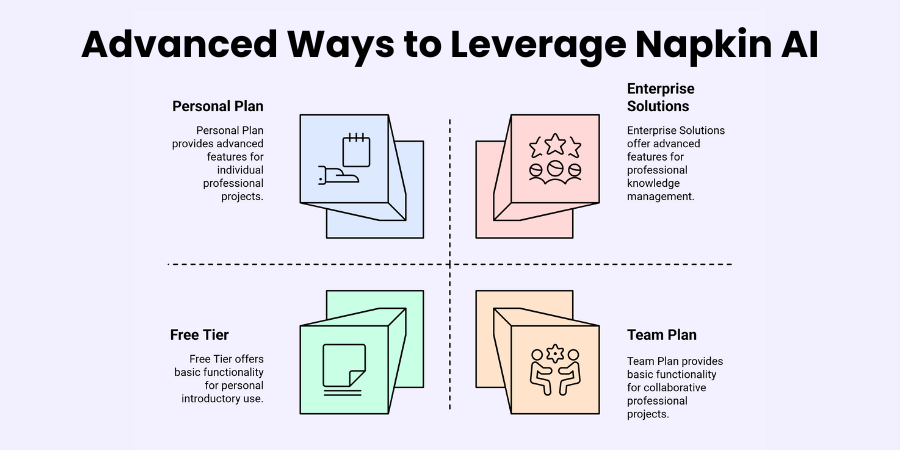
Content Brainstorming and Development
Professional writers use Napkin AI to overcome creative blocks by generating unexpected connections between concepts. The platform excels at suggesting new angles for articles, stories, or marketing campaigns through relationship mapping. Content strategists leverage the clustering feature to identify content gaps and opportunities within existing materials. The system can analyze published content and suggest areas for expansion or clarification.
Marketing teams use Napkin AI to develop comprehensive campaign ideas that maintain thematic consistency. The connection features ensure messaging remains aligned across different channels and content formats.
Research Synthesis and Academic Applications
Researchers utilize Napkin AI to identify patterns across scientific literature and their own research notes. The platform helps connect findings from different studies that might otherwise remain isolated insights. Academic writers use the system to develop literature reviews by mapping relationships between key sources. The visual representation helps identify schools of thought and theoretical frameworks within complex fields.
Dissertation students leverage Napkin AI to maintain coherence across lengthy research projects spanning months or years. The connection features ensure consistent argumentation and comprehensive coverage of important concepts.
Business Strategy and Innovation
Entrepreneurs use Napkin AI for business model development by connecting market insights with potential solutions. The platform helps identify unique value propositions by revealing unexpected combinations of capabilities and needs. Strategy consultants leverage the system to map competitive landscapes and identify unexplored market opportunities. The visual nature of connections helps communicate complex strategic positions to stakeholders effectively.
Innovation teams use Napkin AI to enhance brainstorming sessions and capture ideas from diverse participants. The system helps identify complementary concepts that might combine into breakthrough innovations.
Personal Knowledge Management
Lifelong learners use Napkin AI to connect concepts across different fields of study and interest. The platform helps identify transferable principles that apply across seemingly unrelated domains. Journal keepers leverage the system to identify patterns in personal reflections and experiences over time. The connection features reveal personal growth trajectories and recurring themes worth exploring further. Career developers use Napkin AI to map skills, experiences, and interests when planning professional transitions. The visual representation helps identify transferable capabilities and potential new directions.
Napkin AI Pricing Plans
Napkin AI offers a tiered pricing structure designed to accommodate different user needs and budgets:
- Free tier: Basic functionality with limited note creation and AI-generated connections
- Personal plan ($9.99 monthly): Unlimited notes, full connection mapping, and basic export options
- Professional plan ($19.99 monthly): Advanced analytics, priority processing, and expanded export capabilities
- Team plan ($49.99 monthly for 5 users): Collaborative workspaces with shared collections
- Enterprise solutions: Custom pricing with dedicated support, advanced security, and integration capabilities
The free tier serves as an introduction to the platform with restrictions on storage and advanced features. The Personal tier suits individual professionals and creators working on personal projects or small workflows. The Professional level targets serious knowledge workers who rely on the platform for daily productivity. The Team option works well for small companies or research groups working on shared projects. Large organizations typically require Enterprise features for departmental or company-wide knowledge management.
Limitations of Napkin AI
Despite its powerful capabilities, Napkin AI presents several limitations that users should consider before adoption. The learning curve can be steeper than expected for users accustomed to traditional note-taking applications. The connection-focused approach requires adjusting how you think about and organize information. Connection quality depends heavily on input quality, with vague notes generating less useful relationships.
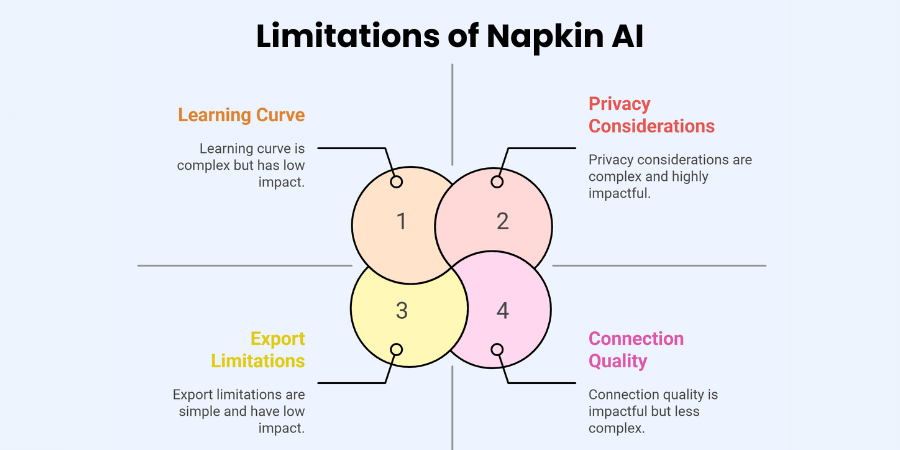
The system performs best with specific, clear content rather than ambiguous or overly general notes. Highly specialized technical topics sometimes receive less accurate connections due to domain-specific terminology. Fields like advanced mathematics or specialized engineering may see fewer valuable automatic connections. The visual mapping can become overwhelming when working with very large collections of notes. Navigation challenges emerge once users exceed several hundred interconnected notes within a single workspace. Privacy considerations arise from the AI analysis of potentially sensitive personal or business information.
Users should review privacy policies carefully before storing confidential or proprietary information in the system. Export limitations can make transitioning to other platforms challenging if you decide to switch tools. The unique connection-based structure does not always translate well to more traditional note-taking systems.
Best Practices for Using Napkin AI
Maintaining consistent note input significantly improves the quality of AI-generated connections over time. Regular additions help the system build a more comprehensive understanding of your thinking patterns. Using descriptive titles for notes enhances both manual searching and AI-powered connection discovery. Clear titles provide context that helps the system make more relevant associations between ideas.
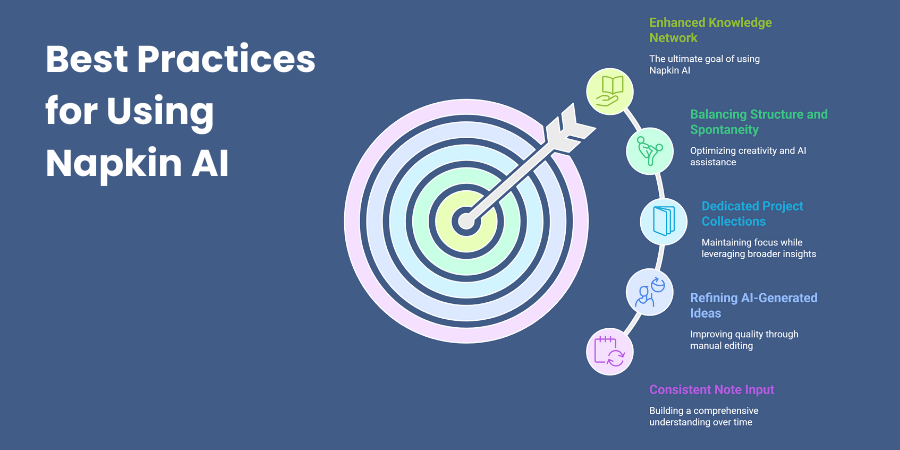
Including relevant keywords within notes improves the accuracy of automatic tagging and clustering. These keywords serve as signals helping the AI understand the conceptual territory of each note. Regularly reviewing suggested connections leads to better refinement of your knowledge network over time. Setting aside time weekly to explore new connections often reveals unexpected insights or opportunities. Refining generated ideas through manual editing improves the quality of exported content for projects. The AI provides solid starting points, but human refinement adds nuance and precision. Creating dedicated collections for major projects helps maintain focus while still benefiting from broader connections.
These collections serve as workspaces while still drawing insights from your entire knowledge base. Balancing structure and spontaneity maximizes the value of both human creativity and AI assistance. Too much structure limits discovery, while too little makes connections less meaningful or useful.
Conclusion
Learning how to use Napkin AI opens new possibilities for creative thinking and knowledge management. Its unique ability to connect scattered ideas transforms them into valuable insights and actionable knowledge. This capability enhances writing, research, and strategic planning across many fields.
While there is a learning curve, the potential benefits make it worth exploring for knowledge workers. The combination of human creativity and artificial intelligence creates a powerful synergy for tackling complex thinking tasks. Start small, experiment with its features, and see how it can reshape your workflow.
By understanding both the capabilities and limitations of Napkin AI, users can leverage it effectively while maintaining critical thinking skills. Napkin AI shows how artificial intelligence can enhance human creativity and problem-solving rather than replace it.
Frequently Asked Questions
Can Napkin AI integrate with other note-taking applications?
Napkin AI offers limited integration with select platforms including Notion, Evernote, and Google Docs. The integration capabilities focus primarily on importing existing notes rather than real-time synchronization. Users can export Napkin AI content to these platforms, though some connection data may not transfer perfectly.
How does Napkin AI handle privacy and data security?
Napkin AI encrypts all user data both in transit and at rest on their secured servers. The company maintains a strict privacy policy prohibiting the use of content for training their AI models. Users can request complete data deletion at any time through the account settings panel.
Is there a significant difference between the mobile and desktop versions?
The desktop version offers the complete feature set including advanced visual mapping and connection exploration tools. The mobile application focuses on quick capture and basic review functionality rather than comprehensive analysis. Most users find a combination of both platforms provides the optimal workflow for different contexts.
How much content should I add before the AI connections become valuable?
Most users report seeing meaningful connections after adding approximately 30-50 substantial notes on related topics. The quality of connections improves significantly as the system accumulates more context about your thinking patterns. Regular additions of 5-10 notes weekly typically maintain momentum and connection quality over time.
Can multiple team members collaborate effectively using Napkin AI?
Team collaboration works best for groups of 2-8 members working on related projects or knowledge domains. The system allows for both shared and private collections within team workspaces for flexible collaboration. Team members can view, comment on, and build upon connections discovered by the AI across the shared knowledge base.
Shaif Azad
Related Post
Top 10 AI Development Companies in New Jersey for Business
Are you searching for the perfect AI development partner in New Jersey? Have you wondered which...
Top 10 AI Development Companies in New Hampshire
Are you watching New Hampshire’s tech landscape transform before your eyes? Your state is quietly becoming...
Top AI Companies in Nebraska Every Business Should Know
Are you a Nebraska business owner wondering how artificial intelligence could transform your operations? Picture this...

